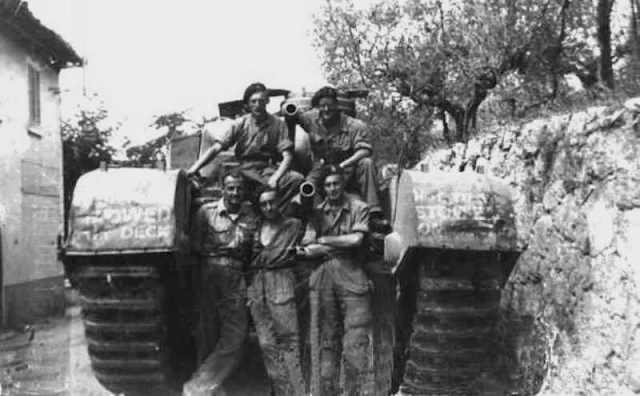 |
| A Churchill tank fitted with a Crocodile flamethrower in action. This flamethrower could produce a jet of flame exceeding 150 yards in length. August 1944. (Imperial War Museum TR 2313) |
 |
| Churchill tanks of A and B Squadrons, 43rd Battalion, Royal Tank Regiment, 33rd Brigade negotiate obstacles during training, October 1942. |
 |
| A Churchill tank of the North Irish Horse crossing the Senio in Italy on two stacked Churchill ARKs, Italy. April 1945. |
 |
| Churchill Crocodile training in England. |
 |
| Churchill infantry tank and crew. |
 |
| Churchill AVRE (Armoured Vehicle Royal Engineers) close-support vehicle. |
 |
| Churchill Crocodile with its flamethrower fuel trailer that carried 400 gallons. |
 |
| Churchill tank in Italy. |
 |
| Churchill Crocodile flamethrower tanks move forward near Imola, Italy, 12 April 1945. |
 |
| The Crocodile’s flamethrower system. |
 |
| A Churchill Crocodile sends some 'love' down range. |
 |
| Churchill Crocodile flamethrower tank, 79th Armoured Division, 13 February 1944. |
 |
| Churchill Crocodile flamethrower on trials, Eastwell Park, Ashford, Kent, 26 April 1944. |
 |
| Churchill Crocodile flamethrower in action during trials at Eastwell Park, Ashford, Kent, 26 April 1944. |
 |
| Churchill Crocodile flamethrowers in action during trials at Eastwell Park, Ashford, Kent, 26 Apr 1944. |
 |
| Churchill Crocodile flamethrower in action during trials at Eastwell Park, Ashford, Kent, 26 April 1944. |
 |
| Churchill Crocodile flamethrowing tank during a demonstration, 25 August 1944. |
 |
| Churchill Crocodile flame-throwing tank during a demonstration, 25 August 1944. |
 |
| A Churchill Crocodile flamethrowing tank during a demonstration, 25 August 1944. Close-up of the fuel trailer. |
 |
| Churchill Crocodile flamethrowing tanks in action during a demonstration, 25 August 1944. |
 |
| Churchill Crocodile flamethrower tank, 25 August 1944. |
 |
| Crocodiles of B Squadron, 141st Royal Armored Corps, which took part in the American attack on Brest. |
 |
| Allied assault force with British Churchill Crocodiles moving on Fort Montbarey. September 1944. |
 |
| Churchill Crocodile in action near Fort Montbarey. Brest, France, September 1944. |
 |
| Churchill Crocodile in action near Fort Montbarey. Brest, France, September 1944. |
 |
| Churchill Crocodile tanks move into position during the attack towards Hertogenbosch, 23 October 1944. |
 |
| Churchill Mk VII Crocodiles and Mk V CS tanks of the 1st Fife and Forfar Yeomanry. Germany, November 1944. |
 |
| A Churchill Crocodile flamethrower in action during a demonstration near Faenza, Italy, 30 December 1944. |
 |
| Churchill Crocodile flamethrowers in action against the village of St Joost, north of Schilberg, during an attack by 1st Rifle Brigade, 20 January 1945. |
 |
| A Churchill Crocodile flame tank supports the crossing of the Senio River in northern Italy by two New Zealand infantry divisions on April 9, 1945. |






No comments:
Post a Comment